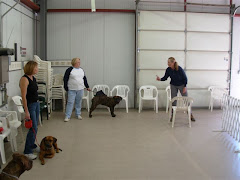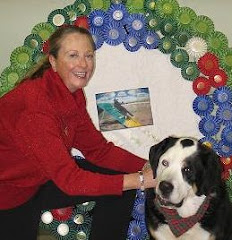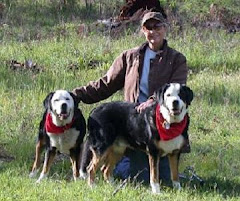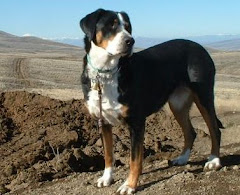Recently I started a four-week class similar to the "Leadership Classes" I taught in Yakima for many years. As my old students will recall, everything we do in Leadership Class starts with what I call the "Leadership Game." I'm once again teaching that to my new students, who are witnessing the same miraculous and quick changes in their dogs' behavior and attitude. As communication improves between handler and dog, the relationship also improves. The dog almost immediately starts to pay attention, show respect, and exercise self control.
I jotted down some notes for my new students on how to play the "Leadership Game," and then I realized I'd written probably my best explanation thus far of this amazing exercise. So I'm sharing it here.....
How
to play “The Leadership Game”
Stand facing your dog, who may be either sitting or
standing—it doesn’t matter, as long as he’s facing you.
Gather the six-foot leash so you are holding the
last 18” of it in your hands, held together at waist level. There should be lots of drape in the leash between
you and the dog. The drape may even drag
on the floor…that’s okay.
Without saying any command or even the dog’s name,
step quickly backward to the end of the leash, giving the leash a HORIZONTAL
zip, snap or jerk (not a pull) as you do it. This
should sharply and suddenly get your dog’s attention and cause him to move
slightly in toward you. As soon as you do this, say something (not a command,
but praise instead) to your dog to bring his attention toward your eyes. Continue praising strongly and confidently to
keep him looking your way. Continue
moving backward, inviting your dog to keep moving in to you. If he wanders past or glances away, again
move quickly to the end of the leash, giving it a horizontal snap, and using
strong words of praise to bring the dog in toward you. Remember to keep both hands together at
waist level on the leash, so that all your physical corrections will move the
dog in toward your center. Keep up this
movement and the vocal praise for several minutes each session.
 If your dog crowds you—comes in TOO close and tries
to step on your toes or push on your body—then bounce him backward a step or
two using your leg. Do not push or shove. BOUNCE! The abruptness of this move will help get
your dog’s attention and respect without hurting either one of you, and it’s a
more natural (dog-on-dog) move—playful and spontaneous.
If your dog crowds you—comes in TOO close and tries
to step on your toes or push on your body—then bounce him backward a step or
two using your leg. Do not push or shove. BOUNCE! The abruptness of this move will help get
your dog’s attention and respect without hurting either one of you, and it’s a
more natural (dog-on-dog) move—playful and spontaneous.
Note:
any bounce or snap of the leash is made relative to the size and disposition of the dog! A big, heavy dog requires more energy. A
small dog requires only a light snap or bounce…just enough to get his attention.
The idea of the "Leadership Game" is to immediately establish your role as the dog’s benevolent
leader. You should be strong, confident,
intimidating yet kind. Your ability to occasionally catch your dog “off guard”
in this exercise (and thus, get in a leash correction) will solidify this role
in your dog’s mind, as you are demonstrating to him that you are faster,
smarter, stronger and more leader like than he is (even if you don’t think you
really are!)
While you do this, your dog should be giving you
100% of his attention. In turn, he gets
100% of yours. In effect, you are taking control of your dog’s mind, almost
like hypnosis, and keeping him in a “trance” of active, submissive, compliant
mindset.
You may see your dog go through transitions during
this process.. At first he may seem happy and willing and playful, with perked
ears and inquisitive forehead. This may
change into a “Why are we doing this?” attitude, which could provoke minor
naughtiness like jumping up, pulling on the leash, or avoiding eye
contact. Getting through these
transitions is crucial. At the end of
your session, whether 15 seconds or 15 minutes, your dog’s demeanor should look
relaxed, his ears down and back, submissive and listening, his forehead back
and smooth instead of furrowed.
You then transition out of the exercise by releasing
with “Okay!” or another happy release word.
Or invite him to jump up on you (a tension reliever). Or ask him to do something else for you. Pat him on the shoulders with strong hands
and exuberant praise that reinforces the idea you are leader and he is
subordinate.
Problem-solving
the Leadership Game:
 If the dog grabs at the leash that’s between you and
him, it may be because you accidentally took up the slack (drape) and the leash
is right in front of his mouth (easy to grab).
If so, lengthen the leash to reestablish the drape. It could also be that you have allowed the
dog to invade your personal “bubble” without realizing it. Your dog will do this on purpose, if you
allow, as a means of regaining control.
This “crowding” can be corrected by YOU walking FORWARD into your dog
and forcing the DOG to BACK UP. This is
also a power move on your part, especially effective with herding dogs whose
natural inclination is to control your foot movement by crowding you. If you have a herding dog, YOU must show him
you’re a better herding dog than he is.
If the dog grabs at the leash that’s between you and
him, it may be because you accidentally took up the slack (drape) and the leash
is right in front of his mouth (easy to grab).
If so, lengthen the leash to reestablish the drape. It could also be that you have allowed the
dog to invade your personal “bubble” without realizing it. Your dog will do this on purpose, if you
allow, as a means of regaining control.
This “crowding” can be corrected by YOU walking FORWARD into your dog
and forcing the DOG to BACK UP. This is
also a power move on your part, especially effective with herding dogs whose
natural inclination is to control your foot movement by crowding you. If you have a herding dog, YOU must show him
you’re a better herding dog than he is.
If the dog “assaults” you while doing this exercise
(i.e., comes forward into you with barking, growling, pawing, or other physical
means of interference with your movements) “assault” back with twice the
force. In other words, if he’s moving in
to you with intent to jump, move forward into him with more force and bounce
him back. The dog is the Volkswagen and
you are the semi-tractor trailer. Teach
him it is his job and duty to “yield” to you.
If the dog is totally non compliant and
uncontrollable, abandon the Leadership Game and instead do the “neck massage”
to calm the dog, using firm but comfortable control with your hands on either
side of his head. Let the dog finish his
tantrum while you talk with strong but soothing words. When you feel him start to relax, the back of
his neck will soften. Now he’s in a good
state of mind (calm, submissive) and
able to handle the requests from you, the calm,
assertive leader.
What
this game does:
- Forces your dog to concentrate (pay attention to you).
- Uses natural body movements understood by the dog to communicate strength and benevolent dominance.
- Calms the dog and removes stressful distractions.
- Convinces your dog you are bigger, faster, stronger and smarter than he is (even if you are not!) and convinces him you are a leader who should be followed and trusted with his life and welfare.
- Puts your dog into a settled state of mind so he’s able to think, listen, hear, and respond to your directions or training.
- Convinces your dog the safest and calmest place for him to be at all times is close to you.
This exercise can be done any time, anywhere for the
rest of your dog’s life. If/when you are
working with your dog and you feel you have lost his attention or respect, go
right back into this exercise until you can observe the positive change in your
dog’s demeanor.
When your dog is in the right state of mind, he is
a sponge ready to learn whatever you want to teach him.
The trainer who originally taught me this exercise was a domineering, ego-maniacal control freak who was so "over the top" that association with him nearly ruined my reputation as a dog trainer. I realized the exercise needed softening and refining to make it palatable to normal people and their sensitive dogs. There's no room for ego in dog training. There is, however, a need for human-to-dog communication skill improvement . So I've spent many years modifying the "Leadership Game" so that the principles will work for all dogs and dispositions. The whole concept deserves a book of its own. Maybe some day...
Note: Those of you familiar with my training and this exercise already know I believe in using a conventional, well fitting "choke chain" for this exercise. The "cha-ching and release" delivered with a quick, horizontal zip of the leash (toward you, the handler), communicates instantly without hurting the dog in any way. After working with some 12,000 dogs or more over the past 27 years, I still find a simple choke chain, used the right way, to be the fastest, most effective and therefore the most humane and respectful way of doing this exercise on the vast majority of dogs.
The trainer who originally taught me this exercise was a domineering, ego-maniacal control freak who was so "over the top" that association with him nearly ruined my reputation as a dog trainer. I realized the exercise needed softening and refining to make it palatable to normal people and their sensitive dogs. There's no room for ego in dog training. There is, however, a need for human-to-dog communication skill improvement . So I've spent many years modifying the "Leadership Game" so that the principles will work for all dogs and dispositions. The whole concept deserves a book of its own. Maybe some day...
Note: Those of you familiar with my training and this exercise already know I believe in using a conventional, well fitting "choke chain" for this exercise. The "cha-ching and release" delivered with a quick, horizontal zip of the leash (toward you, the handler), communicates instantly without hurting the dog in any way. After working with some 12,000 dogs or more over the past 27 years, I still find a simple choke chain, used the right way, to be the fastest, most effective and therefore the most humane and respectful way of doing this exercise on the vast majority of dogs.








No comments:
Post a Comment